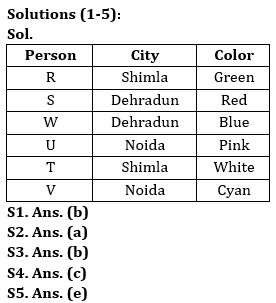Directions (1-5): Answer the following question based on the information given below.
Six people (R, S, T, U, V and W) like different colors among Red, Green, Blue, White, Pink and Cyan. They visit three different cities like Noida, Dehradun, Shimla such that two people visit each city.
The one who likes white does not visit Dehradun. R who likes green, visits Shimla. S and the one who likes blue, visit the same city. U likes pink but does not visit Shimla. T neither likes blue nor visits the same city as U. V likes cyan but does not visit Dehradun.
Q1. W visits which of the following city?
(a) Shimla
(b) Dehradun
(c) Noida
(d) Either Shimla or Noida
(e) None of these
Q2. T likes__________ and visits ________.
(a) White, Shimla
(b) White, Noida
(c) Red, Shimla
(d) Red, Dehradun
(e) None of these
Q3. Who among the following person visits the same city as U?
(a) S
(b) V
(c) W
(d) R
(e) None of these
Q4. Which of the following pair visit Noida?
(a) T, S
(b) T, W
(c) V, U
(d) T, V
(e) None of these
Q5. Which of the following statement is correct?
(a) V likes cyan and visits Shimla
(b) S likes white
(c) W likes blue and visits Noida
(d) T likes red and visits Shimla
(e) U visits Noida
Directions (6-10): In the following questions assuming the given statement to be true, find which of the conclusion(s) among given conclusions is/are definitely true and then give your answers accordingly.
Q6. Statements: K > G = Q > T, L > T < N, N ≥ O
Conclusions: I. K > T
II. O > Q
(a) Only I is true
(b) Only II is true
(c) Either I or II is true
(d) Neither I nor II is true
(e) Both I and II are true
Q7. Statements: K > G = Q > T, L > T < N, N ≥ O
Conclusions: I. G < N
II. T < Q
(a) Only I is true
(b) Only II is true
(c) Either I or II is true
(d) Neither I nor II is true
(e) Both I and II are true
Q8. Statements: K > G > T, L > T < N, N ≥ O, L = Q
Conclusions: I. L > N
II. Q ≤ N
(a) Only I is true
(b) Only II is true
(c) Either I or II is true
(d) Neither I nor II is true
(e) Both I and II are true
Q9. Statement: L < M > R = S < T ≤ U = V = W > X
Conclusions: I. M < V
II. X < U
(a) Only I is true
(b) Only II is true
(c) Either I or II is true
(d) Neither I nor II is true
(e) Both I and II are true
Q10. Statement: F ≥ K < S = Y < M, A > B > E = D > M
Conclusions: I. E > Y
II. K < E
(a) Only I is true
(b) Only II is true
(c) Either I or II is true
(d) Neither I nor II is true
(e) Both I and II are true
Solutions

Solutions (6-10):
S6. Ans. (a)
Sol. I. K > T – True
II. O > Q – False
S7. Ans. (b)
Sol. I. G < N – False
II. T < Q – True
S8. Ans. (c)
Sol. I. L > N – False
II. Q ≤ N – False
S9. Ans. (b)
Sol. I. M < V – False
II. X < U – True
S10. Ans. (e)
Sol. I. E > Y – True
II. K < E – True





 GA Capsule for SBI Clerk Mains 2025, Dow...
GA Capsule for SBI Clerk Mains 2025, Dow...
 The Hindu Review October 2022: Download ...
The Hindu Review October 2022: Download ...
 PNB SO Admit Card 2025 Out, Download Cal...
PNB SO Admit Card 2025 Out, Download Cal...




